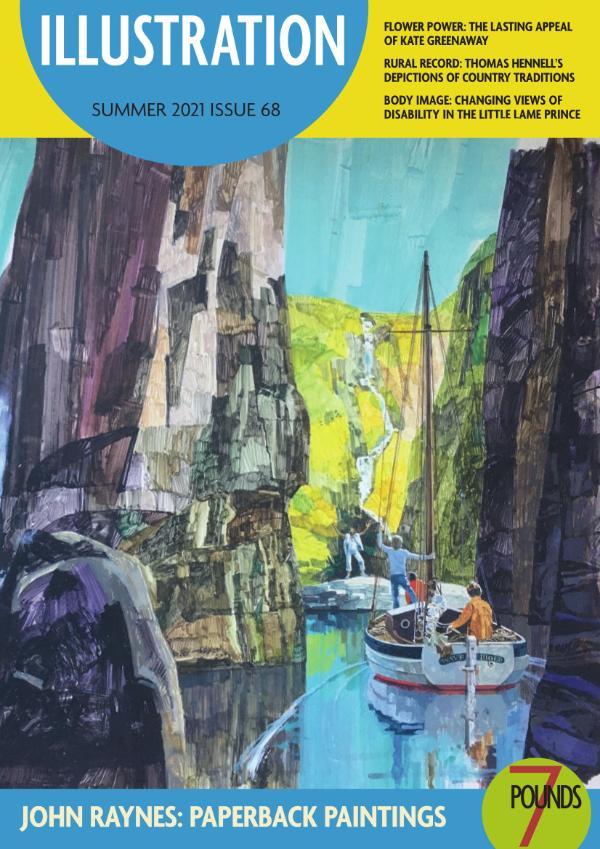
Illustration - Summer 2021 - Issue 68
Contents
Welcome to Issue 68
News and reviews
A brief round-up of current news stories, exhibitions and competitions – plus new books, reader offers, catalogues and websites, auction highlights and dates you need to remember.
Illustrator’s Notebook
Artist, printmaker and illustrator Clive Hicks Jenkins won the V&A book illustration award together with publisher Design for Today for his work on Hansel & Gretel; a Nightmare in Eight Scenes, by Simon Armitage. He is now working on a new version of Beauty and the Beast re-written in poetry by Olivia McCannon and inspired by Hicks-Jenkins’ livelong love of Jean Cocteau’s 1946 film La Belle et la Bête(also to be published by Design for Today). He takes us behind the scenes of the new book and shows us the many layers of sketches that inform his final illustrations.
Kate Greenaway
The most successful woman illustrator of the 19th century set her books not in the period in which they were written and conceived, but in a buccolic, pre-industrial Eden, populated with children dressed in Regency fashions. Kate Greenaway was critically acclaimed in her own lifetime and suffered few of the barriers common to many women artists of her time. However, behind the picturesque, child-centred idyll, her images are carefully and cleverly composed and demonstrate a sophisticated graphic talent.
Thomas Hennell
A friend of Eric Ravilious and Edward Bawden, who greatly admired his work, Thomas Hennell received immediate acclaim for his first book, Change on the Farm, which recorded the regional variations in farming practices, tools and skills that were rapidly dying out in the 1930s. Unfortunately, by the time the book was receiving these critical notices, Hennell had suffered a mental breakdown and he spent the next three years in hospital. His subsequent book was a powerful insider’s expose of British mental health institutions. These two very different books highlight the breadth of his talent and created a legacy of illustrations that have been described as “important” by historians and campaigners ever since.
The Little Lame Prince
Disability was common in Victorian times, but the ways in which it was depicted (or concealed) in books and illustrations tended to fall into two camps: disability that reflected inner deformities in villains; and disabilities that made the person who had them more saintly, sensitive and pitiable. Mrs Craik’s The Little Lame Prince falls into the second category. We look at how three illustrators spanning the past 100 years have drawn the prince and what their interpretation tells us about changing views of disability.
John Raynes
The 1960s and 1970s were boom times for illustrators of paperback book jackets. Developments in printing had made colour reproduction cheaper and publishers were vying to produce the brightest and most modern covers – to encourage new readers to buy old texts as well as the latest novels. John Raynes was at the forefront of this trend, creating striking, graphic covers for Pan and Penguin, as well as work for advertising clients. The publishers, however, often wanted more than a straightforward refection of the plot or characters.
The Great Exhibition and Punch
The first use of the term “The Crystal Palace” to describe Joseph Paxton’s glass exhibition hall appeared in Punch and the magazine went on to praise and lampoon the building on both its sites throughout its existence. We look at what the cartoonists had to say and what they chose to show.
Resources
Look and learn
What are the key events, shows and exhibitions coming up in the next few months? Find out what you can’t afford to miss.
Contributors
Dr Simon Cooke is co-editor of Reading Victorian Illustration 1855-1875 (Burlington, VT: Ashgate, 2012), and the author of Illustrated Periodicals of the 1860s(London: BL, 2010). He has published articles on Victorian literature, art and illustration. His specialist interests include Gothic and Sensationalism, Pre-Raphaelite literature, cultural readings of Victorian texts, book illustration of the 1860s and the book as a material form. His essays have appeared in British and American journals, including Dickens Studies Annual, Dickens Quarterly and Victorian Periodicals Review.
(“A formal Eden”, p8.)
Jessica Kilburn is a freelance writer and researcher from Northumberland. Her book, Thomas Hennell: The Land and the Mind, has recently been published by Pimpernel Press (www.pimpernelpress.com/thomas-hennell).
(“Mind and matter”, p16.)
Dr Catherine J Golden is professor of English and the Tisch Chair in Arts and Letters at Skidmore College. She is author of Serials to Graphic Novels: The Evolution of the Victorian Illustrated Book(Gainesville, FL: UPF, 2017), Posting It: The Victorian Revolution in Letter Writing(Gainesville, FL: UPF, 2009), and Images of the Woman Reader in Victorian British and American Fiction(Gainesville, FL: UPF, 2003). She is also editor or co-editor of five additional books and numerous articles on topics ranging from Charlotte Perkins Gilman to Victorian illustration, literature and culture.
(“Differently abled: differently drawn”, page 24.)
Dr Mark Bryant was an editor in literary and academic book publishing before becoming a writer, journalist, lecturer and exhibition curator. He has written for the Independent, History Today, British Journalism Review,Military History Monthly and other publications. His books include the Dictionary of 20th Century British Cartoonists and Caricaturists, and he has contributed articles to the Oxford Dictionary of National Biography. He is a trustee of the Cartoon Museum.
(“Windows on the world”, page 40.)

